外研高一必修2 Module 4 Fine Arts – Western, Chinese and Pop Arts模块复习课件(56张)
文档属性
| 名称 | 外研高一必修2 Module 4 Fine Arts – Western, Chinese and Pop Arts模块复习课件(56张) | 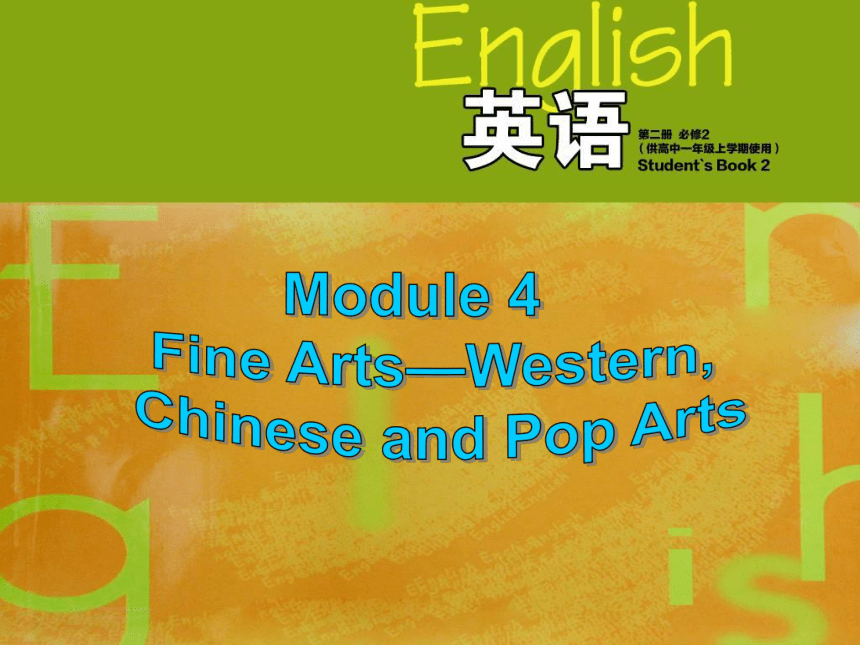 | |
| 格式 | zip | ||
| 文件大小 | 949.1KB | ||
| 资源类型 | 教案 | ||
| 版本资源 | 外研版 | ||
| 科目 | 英语 | ||
| 更新时间 | 2017-01-18 20:05:48 | ||
图片预览

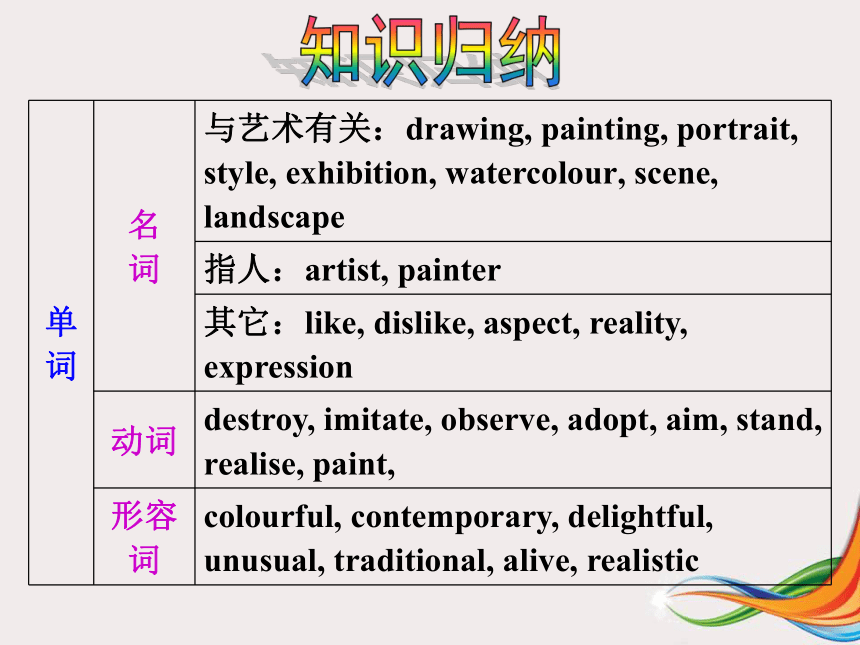


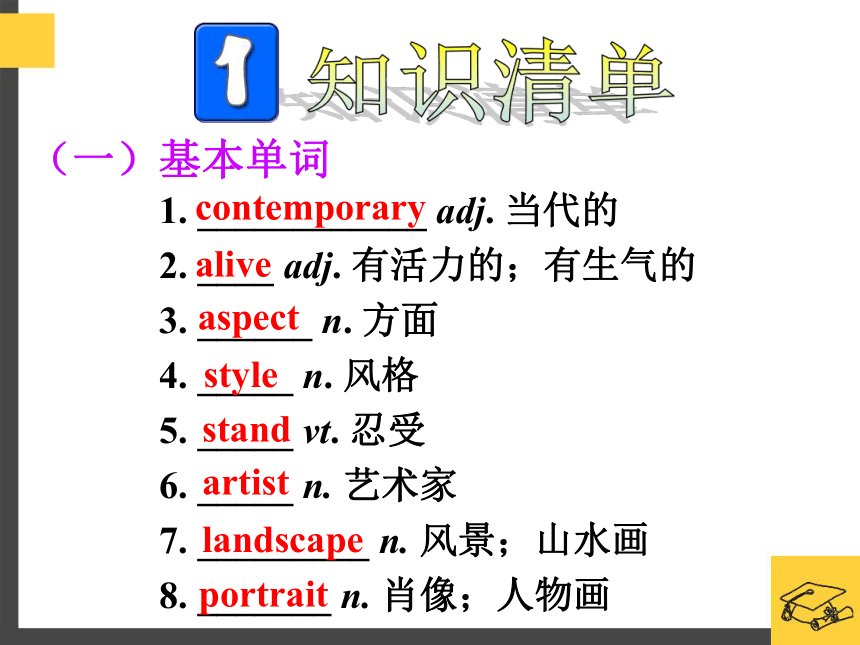

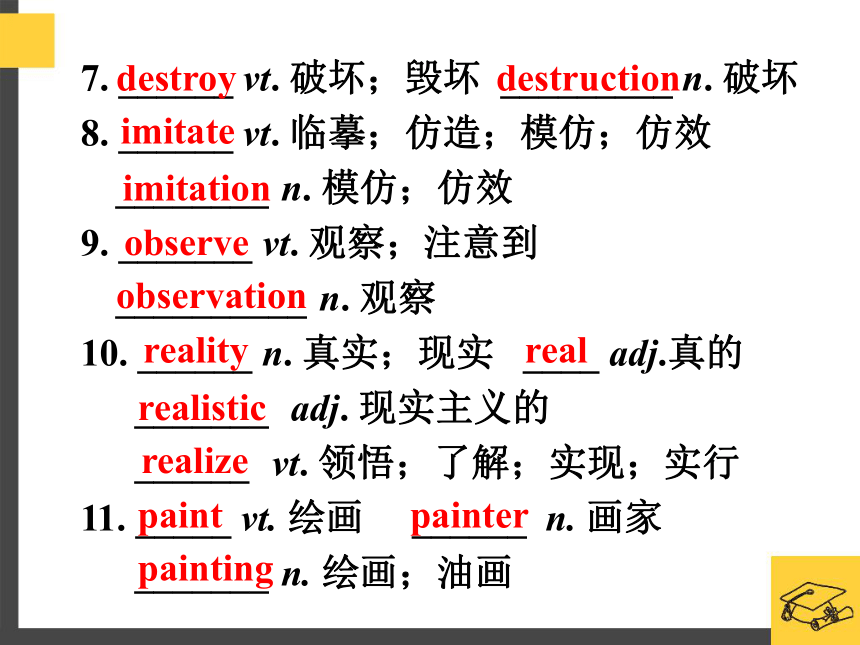
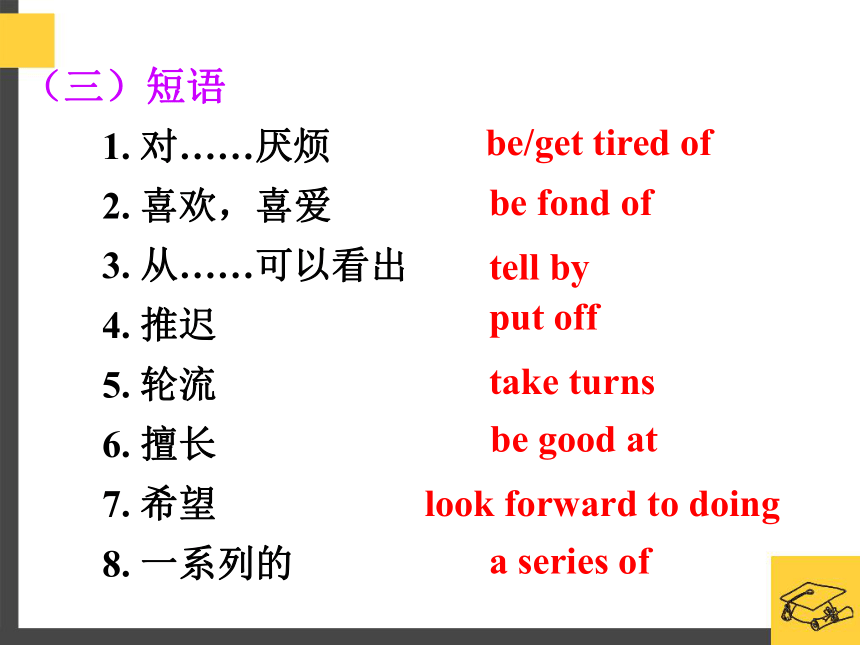
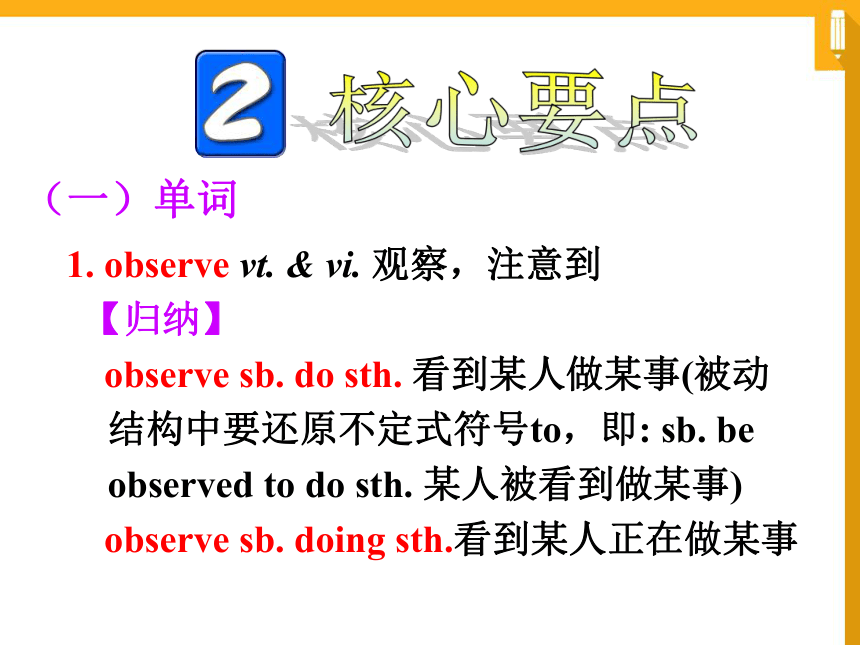
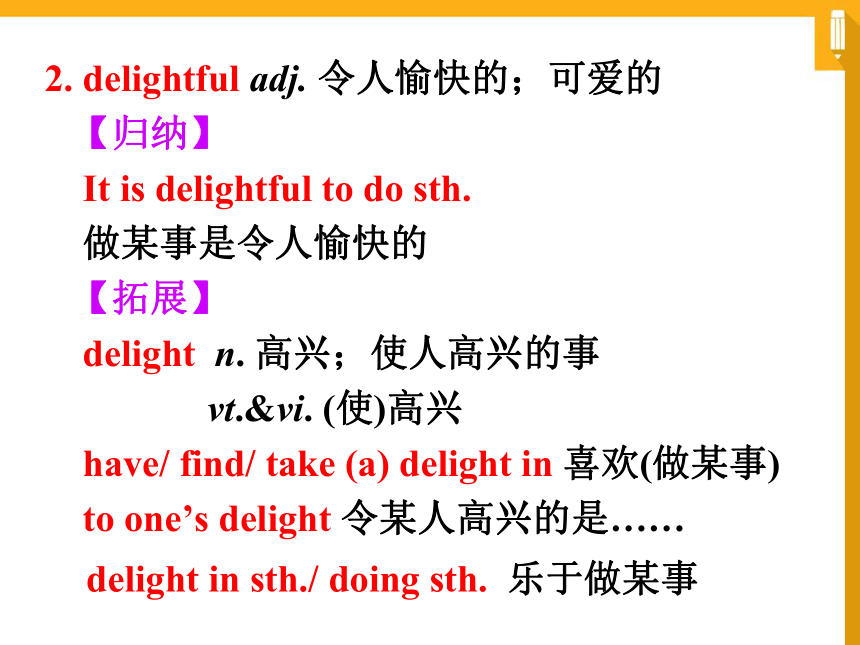

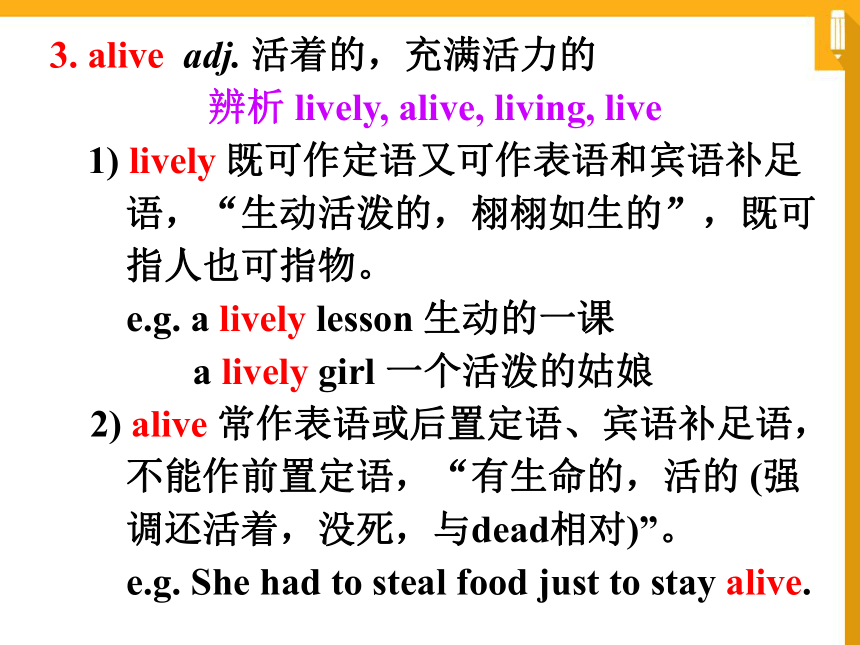
文档简介
课件56张PPT。Module 4
Fine Arts—Western,
Chinese and Pop Arts知识归纳1. ____________ adj. 当代的
2. ____ adj. 有活力的;有生气的
3. ______ n. 方面
4. _____ n. 风格
5. _____ vt. 忍受
6. _____ n. 艺术家
7. _________ n. 风景;山水画
8. _______ n. 肖像;人物画知识清单(一)基本单词contemporaryaliveaspectstylestandartistlandscapeportrait1. ________ adj.令人愉快的;可爱的
______ n. & v. 取悦,高兴
2. _____ n. 景色;风景;场景
_______ (近义词) 景色
3. _________ adj. 传统的;________ n. 传统
4. _____ vt.采纳;采用;收养
________ n. 采纳,采用,收养
5. _________ n. 展览 ______ v. 展览
6. _________ n. 表现;表达 ______ v. 表达(二)派生单词delightfuldelightscenescenerytraditionaltraditionadoptadoptionexhibitionexhibitexpressionexpress7. ______ vt. 破坏;毁坏 _________ n. 破坏
8. ______ vt. 临摹;仿造;模仿;仿效
________ n. 模仿;仿效
9. _______ vt. 观察;注意到
__________ n. 观察
10. ______ n. 真实;现实 ____ adj.真的
_______ adj. 现实主义的
______ vt. 领悟;了解;实现;实行
11. _____ vt. 绘画 ______ n. 画家
_______ n. 绘画;油画destroydestructionimitateimitationobserveobservationrealityrealrealisticrealizepaintpainterpainting1. 对……厌烦
2. 喜欢,喜爱
3. 从……可以看出
4. 推迟
5. 轮流
6. 擅长
7. 希望
8. 一系列的(三)短语be/get tired of be fond oftell byput offtake turnsbe good atlook forward to doinga series of1. observe vt. & vi. 观察,注意到
【归纳】
observe sb. do sth. 看到某人做某事(被动结构中要还原不定式符号to,即: sb. be observed to do sth. 某人被看到做某事)
observe sb. doing sth.看到某人正在做某事(一)单词核心要点2. delightful adj. 令人愉快的;可爱的
【归纳】
It is delightful to do sth.
做某事是令人愉快的
【拓展】
delight n. 高兴;使人高兴的事
vt.&vi. (使)高兴
have/ find/ take (a) delight in 喜欢(做某事)
to one’s delight 令某人高兴的是……
delight in sth./ doing sth. 乐于做某事delighted adj. 高兴的,愉快的,快乐的
be delighted at/ with/ by sth.
对某事感到高兴
be delighted to do sth.
很高兴做某事3. alive adj. 活着的,充满活力的
辨析 lively, alive, living, live
1) lively 既可作定语又可作表语和宾语补足语,“生动活泼的,栩栩如生的”,既可指人也可指物。
e.g. a lively lesson 生动的一课
a lively girl 一个活泼的姑娘
2) alive 常作表语或后置定语、宾语补足语, 不能作前置定语,“有生命的,活的 (强调还活着,没死,与dead相对)”。
e.g. She had to steal food just to stay alive.3) living 既可作表语又可作前置定语,“活的,健在的,现行的,现代的(强调健在)”。
e.g. She had a strange way of making her
classes lively and interesting.
4) live “活着的,有生命的(修饰物)”,只作定语;“现场直播的”时候,既可作定语又可作表语。
e.g. a live fish
This evening there will be a live
broadcast of the debate. 4. adopt vt. 采纳,采取;批准;领养
【归纳】
adopt an idea/a plan 采纳意见/计划
adopt a child 领养孩子
【拓展】
adoption n. 采纳,采用,收养
adopted adj. 被收养的;被采用的辨析adapt与adopt
adapt vt. 使适应;改写,改编
e.g. It took him a while to adapt himself to his new surroundings.
adopt vt.采用,采纳;收养
e.g. She was left an orphan and a poor peasant woman?adopted?her. We should?adopt?the consumers’ suggestion. 5. stand vt. 忍受;承担;使站立;竖放
n. 看台,摊子;立场;站立;停住
【归纳】
“忍受,容忍”时,常用于否定句、疑问句或条件句中,与can或could连用,后需跟名词、代词、v.-ing形式作宾语。
can’t stand sth./ doing sth. 不能忍受(做)某事
can’t stand sb./ sth. doing sth.
不能忍受某人/物做某事stand back 靠后站;不参与
stand by 支持;遵守
stand for 代表;象征
stand out 突出;坚持抵抗;醒目
stand on one’s head 倒立
stand still 站着不动
take one’s stand 站在某人的立场6. destroy vt. 摧毁,毁灭;打破(希望,计划)
辨析destroy, damage, ruin
1) destroy 只用作动词,“彻底破坏”以至于不可能修复,“破坏、毁灭”,也可以指希望、计划等破灭。
e.g. You have destroyed my hopes of
happiness.
2) damage 部分“损坏、损害、破坏”或指使
用价值有所降低。它可以作动词,也可以
作名词,常与to sth.连用。
e.g. The car was only slightly damaged in
the accident.3) ruin 表示严重破坏,以至于不能修复,但这种破坏不像destroy那样毁灭某物,而是强调致使该物的使用价值发生了变化。作动词时,“使毁灭,使崩溃,弄糟”;作名词时,“毁灭,瓦解,废墟”等抽象概念。
e.g. The flood ruined many precious
paintings.1. tell by 从……可以看出
【拓展】
tell A from B 把A和B分辨开
tell of/ about
公布;说明;讲述
tell the truth 说出真相(二)短语2. put off 延期,推迟
【拓展】
put aside 把……放在一边;节省
put back 把……放回原处;拨回
put down 拒绝;制止
put out 伸出;发布;熄灭
put up 张贴;建造
put up with 忍受;容忍3. take turns 轮流
【拓展】
take turns to do sth.=take turns in doing sth.
=do sth. by turns 轮流做某事
by turns 轮流地;依次;时而……,时
而…… (指动作或现象的交替出现)
in turn 反过来;依次;轮流(按照顺序)
It’s one’s turn to do sth.
轮到某人做某事4. at one’s best 在全盛时期,处于最佳状态
【拓展】
at best 至多,说得再好一点;
do/ try one’s best 尽力
for the best 往好里(想、做)
make the best of 尽量利用
to the best of one’s knowledge?
据某人所知5. can’t stand 不能容忍
【拓展】
can’t bear/ stand to do/ doing sth.?
不能容忍做某事
can’t bear/ stand sb. doing sth.?
不能容忍某人做某事
can’t resist doing sth.?
情不自禁/忍不住做某事
can’t help doing sth.?不能防止或避免做某事
can’t wait to do sth.?迫不及待想做某事 I. 根据本模块所学单词及提示写出所缺单词的正确形式。
1. The letter was written in a formal
s_____.
2. Only the names are ancient; the
characters are modern and ____________
(当代的).style?contemporary 3. It was a d________ concert and I really enjoyed myself yesterday.
4. The boat in the harbour made a beautiful s_____.
5. She knew that the girls used to ________ (模仿) her and laugh at her behind her back.
6. The courts were asked to _______ (采纳) a more flexible approach to young offenders.imitatedelightful ?scene?adoptII. 用括号内单词的正确形式填空。
1. People wore ________ (colour)
clothes and seemed to be having a
good time.
2. Huang was a court ________ (paint)
of the Five Dynasties and most of his
works were of rare flowerspainter colourful3. It’s ________ (tradition) in America to eat turkey on Thanksgiving Day.
4. It’s ________ (usual) to have adult conversation like that with such a young child.
5. She never agreed to the public ________ (exhibit) of her sculptures while she was still alive.exhibitiontraditionalunusual?1. This is a painting by the Spanish artist,Pablo Picasso, considered to be the greatest western artist of the twentieth century.
这是西班牙画家帕布洛·毕加索的一幅油画,他被认为是20世纪西方最伟大的艺术家。
consider 构成的常用句型:(三)句式1) consider (考虑) 可用于进行时:
n./ pron.
doing sth.
that–clause
疑问词+ to do sth.
e.g. He’s considering changing his job.
You have to consider what to do next.
Do you consider that we can finish the
project ahead of time? consider +2) consider(认为)无进行时:consider +it + adj./ n.+ to do/ doing sth.
认为做某事是……
it + adj.+ that… 认为……
sb./ sth.+ (to be/as) + n./ adj.
把……看做……e.g. We consider it necessary to tell him about it.
We considered our English teacher to be our good friend. 3) It is considered that sb. has done
=sb. be considered to have done
某人被认为已做……
e.g. Yuan Longping is considered to
have discovered a special type of
rice plant.2. What do you make of (it)?
你认为(它)怎么样?
1) make of 把……认为/理解为……,常用于what引导的疑问句或否定句中。
2) What do you make of sth.? 相当于What do you think of sth.? 或What’s your opinion of sth.?3) make of 理解,看待,认为
make the best/ most of... 充分利用/享用
make much of sth. 理解(常用于否定句中)
make nothing of 不理解
e.g. What do you make of the new manager?
I can’t make anything of what he said.
I didn’t make much of his speech, did
you?【拓展】
make up 化妆
make… of/ from… 制造
make up for sth. 弥补;补偿
make a living 谋生
make it 成功;算出
make the most of sb./ sth. 充分利用;享受
make off 匆忙离开;逃跑语法动词-ing形式用法小结
【归纳】动词-ing形式在句中可充当主语、宾语、表语、定语、宾语补足语和状语等成分。本期主要讲解其作主语、宾语和表语的用法。【拓展】有些动词(短语)后接动词-ing形式和动词不定式作宾语是有区别的。如:用括号内动词的适当形式填空。
1. Have you given up ________ (drink) whiskey before breakfast?
2. __________ (swim) is good for health.
3. I couldn’t imagine ______ (live) in a place like that.?living???drinking?Swimming?4. I didn’t mean ________ (hurt) you.
5. My new job will mean _________ (travel) all over the world.
6. I ended up ________ (spend) the night at the airport because of the heavy rain. spendingto hurt?travelling??写作如何介绍一幅绘画作品
【写作任务】
假设你是李华,学校安排你陪同一批英国暑期交流生去某博物馆参观。请你根据图片向他们介绍该馆收藏的宋代画家赵孟坚的《岁寒三友图》(The Three Friends of Winter)。注意:
1. 词数100左右;
2. 内容充实,结构完整,语意连贯;
3. 参考词汇:宋代the Song Dynasty??? 松树pine? 梅花plum blossom【写作指导】
1. 审题定调:
本写作要求介绍中国国画《岁寒三友图》, 属于说明文。介绍时要把该作品的主题或其所折射出的某种观念、思想或情绪表达清楚, 从而给欣赏者以美的艺术享受。
2. 确定主体内容:
全文可分为三部分:
第一部分: 简单介绍该作品及其作者;
第二部分: 详细介绍该作品的具体内容及其意义;
第三部分: 总结及评价。3. 确定人称、时态:
人称用第三人称,时态以一般现在时为主。
4. 常用表达:
... is a traditional Chinese painting.
... has a beautiful brush line.
in a very skillful way
with a different style of painting
... can stand cold weather.
... is a symbol of ...
... shows us not only ... but also ...【参考范文】
This is a traditional Chinese painting, named The Three Friends of Winter, by Zhao Mengjian in the Song Dynasty.
From the painting, we can tell Zhao Mengjian has a beautiful brush line. The pine, bamboo and plum blossom are grouped together in a very skillful way, each with a different style of painting. Unlike other plants, the three can stand cold weather and are still alive in winter. In Chinese culture, they are a symbol of our Chinese spirit of strong will.
This painting shows us not only a beautiful picture of nature but also the artist’s painting style, feelings and thoughts.I.?根据括号内的汉语提示补全下列句子(每空一词)。巩固练习1. She gave ___ ______ ____ ________ (一系列的讲座) on contemporary British writers at Warwick University last year. a series of lectures ???2. If you do the same thing for a long time, you will ____ ____ ___ __ (对它感到厌烦).
3. The match has been _____ ____ (推迟) until tomorrow because of bad weather.
4. The doctors are working very hard to ______ ____ _____ (使他活着).
5. When he was six years old, Frank began to ________ ____ ________ ___ _________ (对篮球产生兴趣).get tired of it develop an interest in basketball put off ?keep him aliveII. 阅读下面材料, 在空白处填入适当的内容(不多于3个单词)或括号内单词的正确形式。Shen Jingdong is a contemporary Chinese artist. He 1. ________ (bear) in Nanjing in 1965. After studying art at college, he 2. ________ (spend) sixteen years in the army. When he left the army in 2007, his international career 3. _____ an artist quickly developed with his “Hero” seriesaswas bornspent ?of sculptures and 4. _________ (paint). Inspired by a photo of himself in uniform, he says at first his aim was simply to portray himself as a hero. He began with clay, then porcelain and finally oil paint. He then painted and sculpted a series of portraits of soldiers from all military services and 5. _________ (eventual) people from all social walks of life. His portraits have simple titlespaintings?eventually??like “Air Force,” which is of a uniformed pilot, and “Army,” which is of a soldier in a green uniform. They 6. __________ (paint) in brilliant blues, greens, reds or yellows and in a colourful cartoon-like style 7. ______ soft or even cute features, 8. ________ (look) more like something 9. ______ you might find in a children’s toy shop rather than a parade ground. Shen Jingdong’s work can beare paintedthatwithlooking ?seen at public and private art shows all over the world. The actress Zhang Ziyi is a(n) 10. ________ (collect) of his work.? collector ?
Fine Arts—Western,
Chinese and Pop Arts知识归纳1. ____________ adj. 当代的
2. ____ adj. 有活力的;有生气的
3. ______ n. 方面
4. _____ n. 风格
5. _____ vt. 忍受
6. _____ n. 艺术家
7. _________ n. 风景;山水画
8. _______ n. 肖像;人物画知识清单(一)基本单词contemporaryaliveaspectstylestandartistlandscapeportrait1. ________ adj.令人愉快的;可爱的
______ n. & v. 取悦,高兴
2. _____ n. 景色;风景;场景
_______ (近义词) 景色
3. _________ adj. 传统的;________ n. 传统
4. _____ vt.采纳;采用;收养
________ n. 采纳,采用,收养
5. _________ n. 展览 ______ v. 展览
6. _________ n. 表现;表达 ______ v. 表达(二)派生单词delightfuldelightscenescenerytraditionaltraditionadoptadoptionexhibitionexhibitexpressionexpress7. ______ vt. 破坏;毁坏 _________ n. 破坏
8. ______ vt. 临摹;仿造;模仿;仿效
________ n. 模仿;仿效
9. _______ vt. 观察;注意到
__________ n. 观察
10. ______ n. 真实;现实 ____ adj.真的
_______ adj. 现实主义的
______ vt. 领悟;了解;实现;实行
11. _____ vt. 绘画 ______ n. 画家
_______ n. 绘画;油画destroydestructionimitateimitationobserveobservationrealityrealrealisticrealizepaintpainterpainting1. 对……厌烦
2. 喜欢,喜爱
3. 从……可以看出
4. 推迟
5. 轮流
6. 擅长
7. 希望
8. 一系列的(三)短语be/get tired of be fond oftell byput offtake turnsbe good atlook forward to doinga series of1. observe vt. & vi. 观察,注意到
【归纳】
observe sb. do sth. 看到某人做某事(被动结构中要还原不定式符号to,即: sb. be observed to do sth. 某人被看到做某事)
observe sb. doing sth.看到某人正在做某事(一)单词核心要点2. delightful adj. 令人愉快的;可爱的
【归纳】
It is delightful to do sth.
做某事是令人愉快的
【拓展】
delight n. 高兴;使人高兴的事
vt.&vi. (使)高兴
have/ find/ take (a) delight in 喜欢(做某事)
to one’s delight 令某人高兴的是……
delight in sth./ doing sth. 乐于做某事delighted adj. 高兴的,愉快的,快乐的
be delighted at/ with/ by sth.
对某事感到高兴
be delighted to do sth.
很高兴做某事3. alive adj. 活着的,充满活力的
辨析 lively, alive, living, live
1) lively 既可作定语又可作表语和宾语补足语,“生动活泼的,栩栩如生的”,既可指人也可指物。
e.g. a lively lesson 生动的一课
a lively girl 一个活泼的姑娘
2) alive 常作表语或后置定语、宾语补足语, 不能作前置定语,“有生命的,活的 (强调还活着,没死,与dead相对)”。
e.g. She had to steal food just to stay alive.3) living 既可作表语又可作前置定语,“活的,健在的,现行的,现代的(强调健在)”。
e.g. She had a strange way of making her
classes lively and interesting.
4) live “活着的,有生命的(修饰物)”,只作定语;“现场直播的”时候,既可作定语又可作表语。
e.g. a live fish
This evening there will be a live
broadcast of the debate. 4. adopt vt. 采纳,采取;批准;领养
【归纳】
adopt an idea/a plan 采纳意见/计划
adopt a child 领养孩子
【拓展】
adoption n. 采纳,采用,收养
adopted adj. 被收养的;被采用的辨析adapt与adopt
adapt vt. 使适应;改写,改编
e.g. It took him a while to adapt himself to his new surroundings.
adopt vt.采用,采纳;收养
e.g. She was left an orphan and a poor peasant woman?adopted?her. We should?adopt?the consumers’ suggestion. 5. stand vt. 忍受;承担;使站立;竖放
n. 看台,摊子;立场;站立;停住
【归纳】
“忍受,容忍”时,常用于否定句、疑问句或条件句中,与can或could连用,后需跟名词、代词、v.-ing形式作宾语。
can’t stand sth./ doing sth. 不能忍受(做)某事
can’t stand sb./ sth. doing sth.
不能忍受某人/物做某事stand back 靠后站;不参与
stand by 支持;遵守
stand for 代表;象征
stand out 突出;坚持抵抗;醒目
stand on one’s head 倒立
stand still 站着不动
take one’s stand 站在某人的立场6. destroy vt. 摧毁,毁灭;打破(希望,计划)
辨析destroy, damage, ruin
1) destroy 只用作动词,“彻底破坏”以至于不可能修复,“破坏、毁灭”,也可以指希望、计划等破灭。
e.g. You have destroyed my hopes of
happiness.
2) damage 部分“损坏、损害、破坏”或指使
用价值有所降低。它可以作动词,也可以
作名词,常与to sth.连用。
e.g. The car was only slightly damaged in
the accident.3) ruin 表示严重破坏,以至于不能修复,但这种破坏不像destroy那样毁灭某物,而是强调致使该物的使用价值发生了变化。作动词时,“使毁灭,使崩溃,弄糟”;作名词时,“毁灭,瓦解,废墟”等抽象概念。
e.g. The flood ruined many precious
paintings.1. tell by 从……可以看出
【拓展】
tell A from B 把A和B分辨开
tell of/ about
公布;说明;讲述
tell the truth 说出真相(二)短语2. put off 延期,推迟
【拓展】
put aside 把……放在一边;节省
put back 把……放回原处;拨回
put down 拒绝;制止
put out 伸出;发布;熄灭
put up 张贴;建造
put up with 忍受;容忍3. take turns 轮流
【拓展】
take turns to do sth.=take turns in doing sth.
=do sth. by turns 轮流做某事
by turns 轮流地;依次;时而……,时
而…… (指动作或现象的交替出现)
in turn 反过来;依次;轮流(按照顺序)
It’s one’s turn to do sth.
轮到某人做某事4. at one’s best 在全盛时期,处于最佳状态
【拓展】
at best 至多,说得再好一点;
do/ try one’s best 尽力
for the best 往好里(想、做)
make the best of 尽量利用
to the best of one’s knowledge?
据某人所知5. can’t stand 不能容忍
【拓展】
can’t bear/ stand to do/ doing sth.?
不能容忍做某事
can’t bear/ stand sb. doing sth.?
不能容忍某人做某事
can’t resist doing sth.?
情不自禁/忍不住做某事
can’t help doing sth.?不能防止或避免做某事
can’t wait to do sth.?迫不及待想做某事 I. 根据本模块所学单词及提示写出所缺单词的正确形式。
1. The letter was written in a formal
s_____.
2. Only the names are ancient; the
characters are modern and ____________
(当代的).style?contemporary 3. It was a d________ concert and I really enjoyed myself yesterday.
4. The boat in the harbour made a beautiful s_____.
5. She knew that the girls used to ________ (模仿) her and laugh at her behind her back.
6. The courts were asked to _______ (采纳) a more flexible approach to young offenders.imitatedelightful ?scene?adoptII. 用括号内单词的正确形式填空。
1. People wore ________ (colour)
clothes and seemed to be having a
good time.
2. Huang was a court ________ (paint)
of the Five Dynasties and most of his
works were of rare flowerspainter colourful3. It’s ________ (tradition) in America to eat turkey on Thanksgiving Day.
4. It’s ________ (usual) to have adult conversation like that with such a young child.
5. She never agreed to the public ________ (exhibit) of her sculptures while she was still alive.exhibitiontraditionalunusual?1. This is a painting by the Spanish artist,Pablo Picasso, considered to be the greatest western artist of the twentieth century.
这是西班牙画家帕布洛·毕加索的一幅油画,他被认为是20世纪西方最伟大的艺术家。
consider 构成的常用句型:(三)句式1) consider (考虑) 可用于进行时:
n./ pron.
doing sth.
that–clause
疑问词+ to do sth.
e.g. He’s considering changing his job.
You have to consider what to do next.
Do you consider that we can finish the
project ahead of time? consider +2) consider(认为)无进行时:consider +it + adj./ n.+ to do/ doing sth.
认为做某事是……
it + adj.+ that… 认为……
sb./ sth.+ (to be/as) + n./ adj.
把……看做……e.g. We consider it necessary to tell him about it.
We considered our English teacher to be our good friend. 3) It is considered that sb. has done
=sb. be considered to have done
某人被认为已做……
e.g. Yuan Longping is considered to
have discovered a special type of
rice plant.2. What do you make of (it)?
你认为(它)怎么样?
1) make of 把……认为/理解为……,常用于what引导的疑问句或否定句中。
2) What do you make of sth.? 相当于What do you think of sth.? 或What’s your opinion of sth.?3) make of 理解,看待,认为
make the best/ most of... 充分利用/享用
make much of sth. 理解(常用于否定句中)
make nothing of 不理解
e.g. What do you make of the new manager?
I can’t make anything of what he said.
I didn’t make much of his speech, did
you?【拓展】
make up 化妆
make… of/ from… 制造
make up for sth. 弥补;补偿
make a living 谋生
make it 成功;算出
make the most of sb./ sth. 充分利用;享受
make off 匆忙离开;逃跑语法动词-ing形式用法小结
【归纳】动词-ing形式在句中可充当主语、宾语、表语、定语、宾语补足语和状语等成分。本期主要讲解其作主语、宾语和表语的用法。【拓展】有些动词(短语)后接动词-ing形式和动词不定式作宾语是有区别的。如:用括号内动词的适当形式填空。
1. Have you given up ________ (drink) whiskey before breakfast?
2. __________ (swim) is good for health.
3. I couldn’t imagine ______ (live) in a place like that.?living???drinking?Swimming?4. I didn’t mean ________ (hurt) you.
5. My new job will mean _________ (travel) all over the world.
6. I ended up ________ (spend) the night at the airport because of the heavy rain. spendingto hurt?travelling??写作如何介绍一幅绘画作品
【写作任务】
假设你是李华,学校安排你陪同一批英国暑期交流生去某博物馆参观。请你根据图片向他们介绍该馆收藏的宋代画家赵孟坚的《岁寒三友图》(The Three Friends of Winter)。注意:
1. 词数100左右;
2. 内容充实,结构完整,语意连贯;
3. 参考词汇:宋代the Song Dynasty??? 松树pine? 梅花plum blossom【写作指导】
1. 审题定调:
本写作要求介绍中国国画《岁寒三友图》, 属于说明文。介绍时要把该作品的主题或其所折射出的某种观念、思想或情绪表达清楚, 从而给欣赏者以美的艺术享受。
2. 确定主体内容:
全文可分为三部分:
第一部分: 简单介绍该作品及其作者;
第二部分: 详细介绍该作品的具体内容及其意义;
第三部分: 总结及评价。3. 确定人称、时态:
人称用第三人称,时态以一般现在时为主。
4. 常用表达:
... is a traditional Chinese painting.
... has a beautiful brush line.
in a very skillful way
with a different style of painting
... can stand cold weather.
... is a symbol of ...
... shows us not only ... but also ...【参考范文】
This is a traditional Chinese painting, named The Three Friends of Winter, by Zhao Mengjian in the Song Dynasty.
From the painting, we can tell Zhao Mengjian has a beautiful brush line. The pine, bamboo and plum blossom are grouped together in a very skillful way, each with a different style of painting. Unlike other plants, the three can stand cold weather and are still alive in winter. In Chinese culture, they are a symbol of our Chinese spirit of strong will.
This painting shows us not only a beautiful picture of nature but also the artist’s painting style, feelings and thoughts.I.?根据括号内的汉语提示补全下列句子(每空一词)。巩固练习1. She gave ___ ______ ____ ________ (一系列的讲座) on contemporary British writers at Warwick University last year. a series of lectures ???2. If you do the same thing for a long time, you will ____ ____ ___ __ (对它感到厌烦).
3. The match has been _____ ____ (推迟) until tomorrow because of bad weather.
4. The doctors are working very hard to ______ ____ _____ (使他活着).
5. When he was six years old, Frank began to ________ ____ ________ ___ _________ (对篮球产生兴趣).get tired of it develop an interest in basketball put off ?keep him aliveII. 阅读下面材料, 在空白处填入适当的内容(不多于3个单词)或括号内单词的正确形式。Shen Jingdong is a contemporary Chinese artist. He 1. ________ (bear) in Nanjing in 1965. After studying art at college, he 2. ________ (spend) sixteen years in the army. When he left the army in 2007, his international career 3. _____ an artist quickly developed with his “Hero” seriesaswas bornspent ?of sculptures and 4. _________ (paint). Inspired by a photo of himself in uniform, he says at first his aim was simply to portray himself as a hero. He began with clay, then porcelain and finally oil paint. He then painted and sculpted a series of portraits of soldiers from all military services and 5. _________ (eventual) people from all social walks of life. His portraits have simple titlespaintings?eventually??like “Air Force,” which is of a uniformed pilot, and “Army,” which is of a soldier in a green uniform. They 6. __________ (paint) in brilliant blues, greens, reds or yellows and in a colourful cartoon-like style 7. ______ soft or even cute features, 8. ________ (look) more like something 9. ______ you might find in a children’s toy shop rather than a parade ground. Shen Jingdong’s work can beare paintedthatwithlooking ?seen at public and private art shows all over the world. The actress Zhang Ziyi is a(n) 10. ________ (collect) of his work.? collector ?
